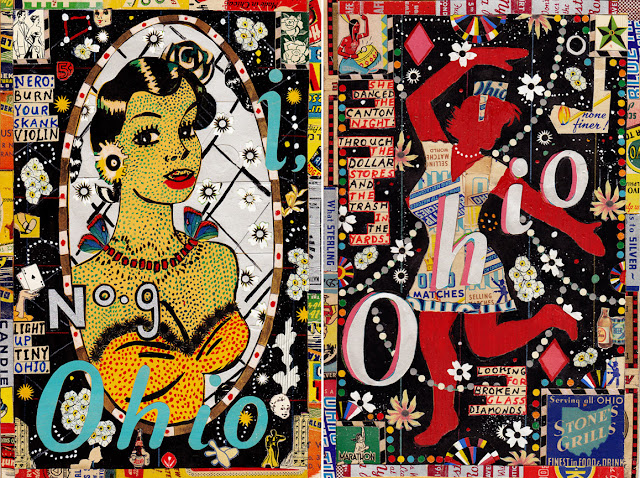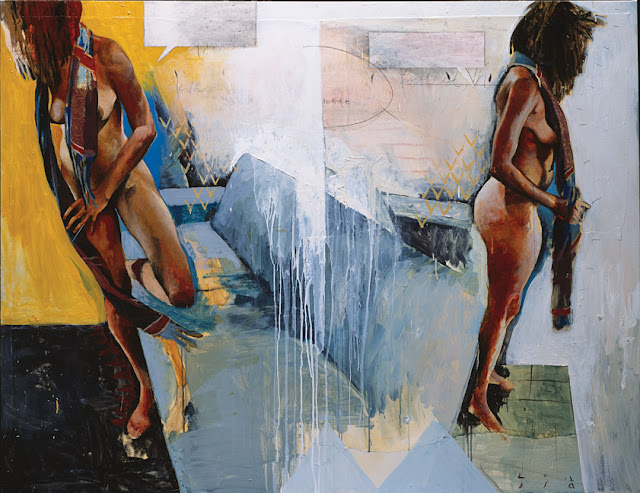Classical music composer, now prolific collage artist, Chambliss Giobbi redefines contemporary collage. Chambliss defines his collaged work as “temporal cubism” and delivers a new series entitled Se7n. Se7n, (The Seven Deadly Sins), is the culmination of 1000s of photographs shot, shredded, torn, cut, assembled, composed and affixed on large aluminum panels (56x92 inches). The final compositions are sealed with layers of bees wax. (Chambliss Giobbi, Se7n—Pride, collage, bees wax on tycore, 56x92 inches, detail).
Time is one of the essential narrative ingredients incorporated within Giobbi’s innovative style of collage. And at first glance, it’s hard to imagine that the final composition is a collage at all. With no digital support and relying solely on photographic prints taken by Chambliss in the studio—subjects, models and environments are sequentially photographed. Each photograph is combined with other photos randomly selected from the same sequence, thus compressing time while reconstructing a new subject all together. (Chambliss Giobbi portraits).
This is essential to further understand Chambliss Giobbi’s personal style of “temporal cubism.” The Cubists created two-dimensional works with the intention of creating the illusion of three-dimensional work. Chambliss asks, “If Picasso and Braque can break down a three-dimensional form to a two-dimensional canvas, why not compress time and it's passing in the same way?’” (Chambliss Giobbi, Se7n—Envy, collage, bees wax on tycore, 56x92 inches, detail).
In Giobbi’s work, three-dimensional forms are captured as two-dimensional photographic sequences. Deconstructed photographs united with different pieces of photographs from the same sequence adds multiple conditions of time. (Chambliss Giobbi, Se7n—Sloth, collage, bees wax on tycore, 56x92 inches, detail).
Chambliss Giobbi’s unique collage style invited me to dig deeper and survey a brief history of important contributions to collage as a significant art form. Though brief, I thought this to assist in further analyzing the importance of Giobbi’s contemporary collage work. (Chambliss Giobbi, Combined Head of Edward & Elinor Giobbi 4 and 7, collage on aluminum panel, 12x12 inches, 2001).
Pablo Picasso and Georges Braque coined the term “collage” in the beginning of the 20th century and soon after became a distinguishing characteristic in the modern art establishment. Collage is derived from the French term, “coller,” meaning glue. Picasso and Braque began their work on Cubism in 1908 and worked closely in the French Pyrenees on a series of works virtually impossible to distinguish the rightful author. Their close collaborations continued up and to the advent of WWI in 1914. (Above, Pablo Picasso, Compotier avec fruits, violon et verre, 1912 and Georges Braque, Photograph of Fruitdish and Glass, 1912, papier collé and charcoal on paper).

Raoul Hausmann, ABCD, 1923-24. Photomontage, 16 x 11.1 inches and Hannah Höch, Cut with the Kitchen Knife through the Beer-Belly of the Weimar Republic, 1919, collage of pasted papers, 90 x 144 cm. Raoul Hausmann was one of the principal figures of Berlin Dada. Hannah Höch was a German Dada artist and one of the originators of the photomontage.
In 1918, Max Ernst closely studied mail-order catalogues and teaching aides and spawned his first collages captured in Fiatmodes, a portfolio of lithographs. Max Ernst would found the Colgne Dada group with friends and colleagues. In the early 1920s Surrealism evolved out of the Dada activities during WWI.
Kurt Schwitters, 1947, The-Holy-Night-by-Antoni-Allegri, known as Corregio and Suprematist Non-Objective Poetry by Cecil Touchon, 18x12 inches, collage on paper. Kurt Schwitters was responsible for the evolution of installation art, site specific transformations of interior spaces. Cecil Touchon is Co-founder of the International Post-Dogmatist Group and Director of the group’s Ontological Museum, Founder of the International Museum of Collage, Assemblage and Construction and founder of the International Society of Assemblage and Collage Artists.
Above, Robert Rauschenburg and Martha Rosler, First Lady (Pat Nixon), 1967-72, Photomontage, 20 x 24." Rauschenberg’s first solo exhibition was held at the Betty Parsons Gallery, New York, in 1951. Robert Rauschenburg’s earliest works were precursory to the Pop Art movement and was a master assembler with non-traditional materials and objects.

Kara Walker is an innovative New York contemporary artist known for her room-size tableaux of black cut-paper silhouettes examining the underbelly of America’s racial and gender tensions. Her work often addresses highly charged themes of power, repression, history, race and sexuality. Kara Walker employs innovative techniques and media ranging from painting and drawing, light projection and written text, to her signature cut-paper silhouette installations, video and live performance. (Above, Kara Walker, 9 works, Untitled, 2001-2005, Collage on paper - 6 works detailed).
Ellen Gallagher is one of today’s leading contemporaries and a collage virtuoso. Ellen exhibits culturally charged discourse while altering repurposed advertising found in Ebony, Sepia and Our World. Ellen’s diverse subject matter presents an organized display of symbols representing social realms of race and gender from time’s past. Ellen Gallagher shares “…I tend to use familiar found elements like penmanship paper and magazines in my work. Using such materials allows the painting to open up in my process of direct drawing — the page becomes both a character and a ground for the work.”

Chambliss Giobbi’s figurative collages work on two levels: Firstly, as objects of obsessive psychological and physical mutation. And secondly, as testaments to an intense personal courtship between artist and model. After a marathon photo session with his subject, Giobbi prints thousands of photographs. He then tears the prints and glues them, piece by piece, layer upon layer, to construct his compositions. What follows is a series of life-sized collages performed in the “temporal cubism” art movement. (Se7n introduction and exhibition information at 101/exhibit in Miami).










































































































































